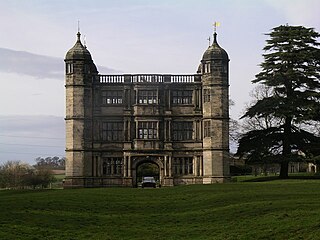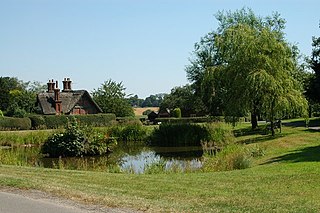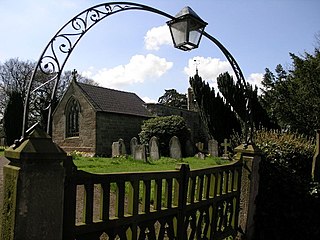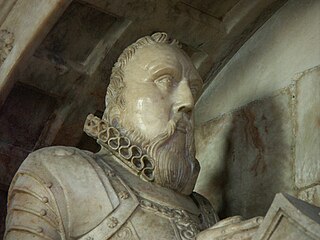
Ashbourne is a market town in the Derbyshire Dales district in Derbyshire, England. Its population was measured at 8,377 in the 2011 census and was estimated to have grown to 9,163 by 2019. It has many historical buildings and independent shops. The town offers a historic annual Shrovetide football match. Its position near the southern edge of the Peak District makes it the closest town to Dovedale, to which Ashbourne is sometimes referred to as the gateway.

St Oswald's Church is a Church of England parish church located in Ashbourne, in the county of Derbyshire, England.

Penelope Boothby was a girl who has become one of the most famous child characters in British art. Her image inspired the paintings by Joshua Reynolds, Henry Fuseli, John Everett Millais, a sculpture by Thomas Banks, photographs of Lewis Carroll, sonnet of Brooke Boothby.

Bradley is a village and civil parish in Derbyshire just east of Ashbourne. The population of the civil parish taken at the 2011 Census was 313. Other neighbouring parishes include Hulland and Yeldersley.

Sir Aston Cockayne, 1st Baronet (1608–1684) Also spelt Aston Cockain was, in his day, a well-known Cavalier and a minor literary figure, now best remembered as a friend of Philip Massinger, John Fletcher, Michael Drayton, Richard Brome, Thomas Randolph, and other writers of his generation.

This is a list of Sheriffs of Derbyshire from 1567 until 1974 and High Sheriffs since.

Tixall Gatehouse is a 16th-century gatehouse situated at Tixall, near Stafford, Staffordshire and is all that remains of Tixall Hall which was demolished in 1927. The gatehouse is a Grade I listed building. Tixall was used as a prison for Mary, Queen of Scots for two weeks in 1586.

Osmaston is a small village and civil parish in the Derbyshire Dales in the county of Derbyshire in England. The population of the civil parish as taken at the 2011 Census was 140.

There have been two baronetcies created for persons with the surname Boothby, both in the Baronetage of England. One creation is extant as of 2022.
The Kniveton Baronetcy, of Mercaston in the County of Derby, was a title in the Baronetage of England. It was created by King James I on 29 June 1611 for William Kniveton of Mercaston Hall, Muggington, Derbyshire. The family originated in the village of Kniveton,, from where their name derived. Branches of the family later had seats at Bradley and by virtue of the 15th century marriage of Nicholas Kniveton, at Mercaston, near Muggington, Derby

Sir Brooke Boothby, 6th Baronet was a British linguist, translator, poet and landowner, based in Derbyshire, England. He was part of the intellectual and literary circle of Lichfield, which included Anna Seward and Erasmus Darwin. In 1766 he welcomed the philosopher Jean-Jacques Rousseau to Ashbourne circles, after Rousseau's short stay in London with Hume. Ten years later, in 1776, Boothby visited Rousseau in Paris, and was given the manuscript of the first part of Rousseau's three-part autobiographic Confessions. Boothby translated the manuscript and published it in Lichfield in 1780 after the author's death, and donated the document to the British Library in 1781.

Edlaston is a village three miles south of Ashbourne in Derbyshire, just off the A515 road. It is in close proximity to the hamlet of Wyaston, and the civil parish is called Edlaston and Wyaston. It had a population of 220 at the 2011 Census.
The Sheriff of Nottinghamshire, Derbyshire and the Royal Forests is a position established by the Normans in England.
This is a partial list of country houses in Derbyshire which have been demolished:

Parwich Hall is a privately owned 18th-century mansion house at Parwich, near Ashbourne, Derbyshire Dales. It is a Grade II* listed building.
Joseph Greaves was a High Sheriff of Derbyshire in 1765.

The Baronetcy of Cockayne of Ashbourne was created in the Baronetage of England on 10 January 1642 for Aston Cockayne, Lord of Ashbourne Hall, Derbyshire and Pooley Hall, Polesworth, Warwickshire.

Pooley Hall is a Manor house built in 1509 on the outskirts of Polesworth, Warwickshire, England. It is a Grade II* listed building and a private residence.
Sir John Cockayne was an English soldier, politician and landowner whose wealth made him a major force in the affairs of Derbyshire under the House of Lancaster. After numerous acts of criminality in concert with other Midlands landowners, he became a member of the Lancastrian affinity centred on John of Gaunt and a supporter of Henry IV. He fought in two campaigns of the Hundred Years War but his violence and lawlessness continued and he was decidedly out of favour during the reign of Henry V. With power less concentrated in the early years of Henry VI, he was able to serve three terms as High Sheriff of Nottinghamshire, Derbyshire and the Royal Forests and to wield considerable power and influence. He represented Derbyshire no less than nine times and Warwickshire twice in the House of Commons of England.

Sir Thomas Cokayne or Cockayne was an English soldier, huntsman, and MP for Derbyshire in March 1553.

















